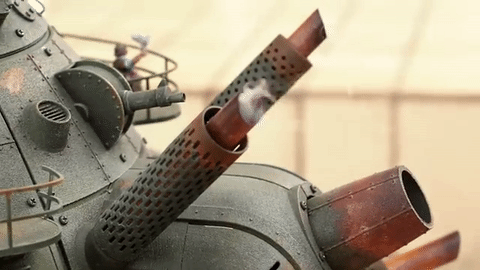
We see a lot of cool projects here at Shapeways but we’ve never seen anything quite like this. Codename Colossus is a massively impressive undertaking. The Gifs below speak for themselves. Built from scratch with over 435 parts, this massive WWII themed robot was designed by Michael Sng founder of Machination Studio. Inspired by a diverse selection of sources, ranging from toys to military experience, these parts were printed in White Strong and Flexible plastic and then laboriously painted and finished to look like a weather worn battle-bot from an alternative timeline of Europe.
We spoke with Michael to learn a little more about his inspiration and why he came to Shapeways to print.

The Colossus is an incredible work of scale miniature art. Can you tell us a little about where you got your Inspiration?
I did my University in the UK and was exposed to miniatures wargaming and model railways there. But being from Singapore, I also grew up watching Japanese anime, Hollywood movies, Hong Kong kung-fu flicks and British comedies. Our house had Playmobil and Legos, Tamiya model kits, and Star Wars action figures. In the 70s and 80s, each culture made very different types of toys and shied away from certain genres. In Singapore, we got them all, roughly in equal measure. So my toy is a combination of all the things I loved as a child merged into one.

I was a conscript in the Singapore Armed Forces, and for two years and four months, I was a mechanic. I fixed Land Rovers and Mercedes Benz and IVECO trucks. My grandfather was a mechanic in the Royal Air Force during World War II while Singapore was still under British Colonial rule. He had to invent the tools needed to open and repair the hydraulic landing gears of the Buffalo bombers because the UK was too tied up in the war to send replacement parts. This all definitely informed my aesthetics.

I guess it’s not a surprise for an Asian to want to make a giant robot, and not being American, I do not live in the shadow of gun violence. I also do not live with the legacy of World War II the way Europeans do, so it is in a completely different context that I designed a toy full of guns.

Why did you choose Shapeways for your manufacturing?
I wanted a high resolution surface finish on my toy, and FDM printers are not quite there yet, so the options were SLA, SLS or PolyJet/MultiJet. I had known about Shapeways for a while, a former colleague of mine sells his toy product through the Shapeways store, so naturally I turned to Shapeways first. What ultimately made me use Shapeways was the fact that I can upload a group of parts at one time to the web application.

My design has 435 parts. I tried another 3D printing service for a price comparison, but immediately realized that with them, I would have to upload each part file individually. The time it would take to upload each file, wait for the automated print checks, find the errors, fix the errors, re-upload the part again, for 435 parts, was a non-starter. With Shapeways, I think my entire toy’s exterior was 5-6 separate uploads each with ten parts. It still took quite a lot of time, but it was manageable. Ideally, I would love to be able to send all my files over in one go and be able to talk to a human being about which parts need changes, but I know that would make a cost impact.

The rough texture of the unpolished prints is easy to paint, although it meant I couldn’t use some techniques like inking. The 11-18 days international turnaround time was also a factor in my decision. This is from the Netherlands to Singapore. Typical air mail would take a week or more alone, so I was very impressed with Shapeway’s speed.

Michael is an incredible scale model maker in the Shapeways community. To learn more and see the Colossus in action check him out on this episode of LinusTechTips. He builds these and other projects on commission, so check out his website if you’re interested.
photo credit to Michael, gifs made via giphy


